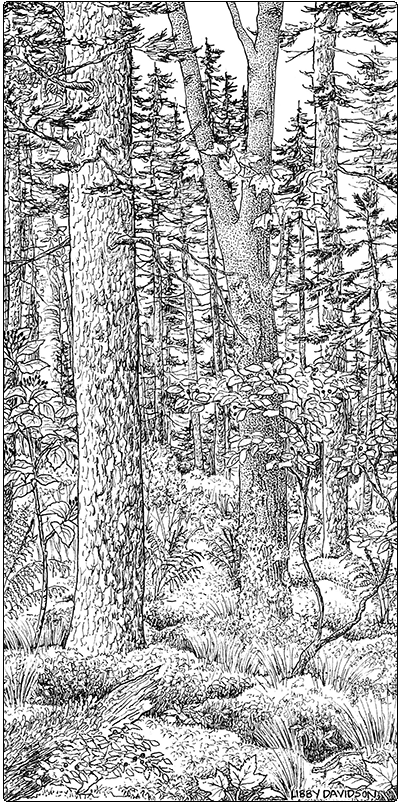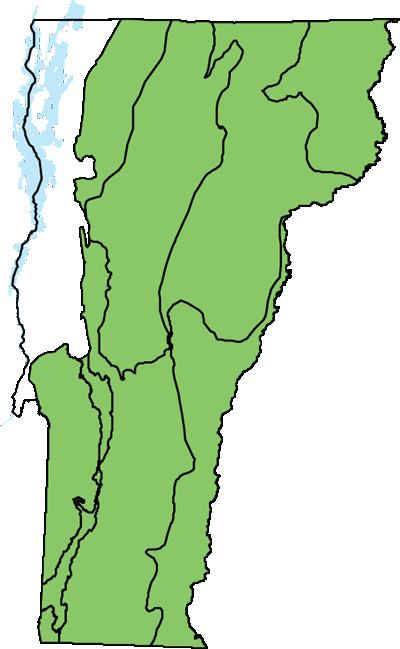Ecology and Physical Setting
Hikers on the Long Trail will know these swamps as places where wooden “bog bridges” cross spruce-shaded, wet carpets of sphagnum moss and fine-leaved sedges. Red Spruce-Cinnamon Fern Swamps occur in small bedrock and till basins or may be part of large wetland complexes. They are especially common on the plateau of the Southern Green Mountains. Most Red Spruce-Cinnamon Fern Swamps occur at moderate to high elevations (between 1,500 and 3,000 feet), but a few examples occur at lower elevations, likely in topographic depressions where cold air accumulates. Many of these swamps are tiny—covering just a fraction of an acre. Even the larger examples rarely exceed 20 acres.
These swamps have substantial peat accumulations, with depths up to 16 feet documented. They typically occur in areas of acidic bedrock or, if they occur in areas with calcareous bedrock, the presence of deep peat isolates the swamp surface from calcium enrichment. There is little surface water in these mossy swamps. Below the swamp surface, water is present most of the year. This water is acidic and poor in dissolved minerals such as calcium and magnesium. Red Spruce-Cinnamon Fern Swamps are typically not associated with larger streams, but they may contain or be the source of small headwater streams.
Vegetation
Red Spruce-Cinnamon Fern Swamps are dominated by red spruce, with lesser amounts of balsam fir. Red maple is variable, co-dominating in some swamps and absent in others. Other trees that may be present in low abundance include yellow birch and white pine. Total canopy cover typically ranges from 70 to 90 percent, but some examples are more open.
The tall shrub layer is well developed and is dominated by mountain holly and wild raisin, although winterberry holly may also be common in patches. Early azalea also occurs in some swamps, dotting the understory with its graceful pink flowers. Low shrubs include velvetleaf blueberry, low sweet blueberry, sheep laurel, and black chokeberry.
Cinnamon fern is the dominant herb, sometimes forming dense stands to near waist height. Creeping snowberry and dwarf raspberry are common on hummocks. Three-seeded sedge is common and forms wispy patches, especially on hummock margins and in the moister, sphagnum-dominated hollows. Indicators of moderate mineral enrichment are occasional in wet hollows. Such plants include slender mannagrass, fowl mannagrass, drooping woodreed, and white turtlehead. Bryophyte cover is typically greater than 80 percent; dominant species are Sphagnum fallax and Sphagnum girgensohnii. Red Spruce-Cinnamon Fern Swamps have relatively low species richness.
Wildlife Habitat

These small swamps with tall red spruce often contrast strikingly with the surrounding upland mixed and deciduous forests. Breeding birds associated with Red Spruce-Cinnamon Fern Swamps include northern waterthrush, Canada warbler, yellow-rumped warbler, Blackburnian warbler, and Magnolia warbler. The uncommon yellow-bellied flycatcher and northern saw-whet owl also nest in these swamps. The primary breeding habitat for yellow-bellied flycatchers in Vermont is in the boreal swamps of the Northeastern Highlands, but Red Spruce-Cinnamon Fern Swamps provide important breeding habitat for this shy, ground-nesting flycatcher on the Southern Green Mountain plateau and elsewhere in the Green Mountains. Red squirrels, southern red-backed voles, and snowshoe hares all use these swamps.
Related Communities
- Spruce-Fir-Tamarack Swamp occurs in the coldest regions and settings of Vermont. Black spruce and tamarack are common canopy associates, and Labrador tea and bog laurel are common shrubs. These species occur only rarely in Red Spruce-Cinnamon Fern Swamps.
- Hemlock-Sphagnum Basin Swamp occurs in warmer settings and is dominated by hemlock, with red spruce only a minor component in some swamps. These very acidic swamps lack seepage indicators like turtlehead and fowl mannagrass.
Conservation Status and Management Considerations
This is an uncommon, small-patch natural community in Vermont. Together, all the swamps occupy a very small percentage of Vermont’s land area and deserve a high level of protection to maintain their ecological integrity. Logging is not recommended. High-quality examples occur on conserved lands throughout the Green Mountains.
Distribution/Abundance
This uncommon natural community occurs primarily in the Northern and Southern Green Mountains, but is also scattered in other biophysical regions, including the Northern and Southern Vermont Piedmonts. Similar communities are recognized across New England and in Québec and New Brunswick.
Characteristic Plants
Trees
Abundant Species
Red spruce – Picea rubens
Occasional to Locally Abundant Species
Balsam fir – Abies balsamea
Red maple – Acer rubrum
Yellow birch – Betula alleghaniensis
White pine – Pinus strobus
Shrubs
Mountain holly – Ilex mucronata
Wild raisin – Viburnum nudum var. cassinoides
Winterberry holly – Ilex verticillata
Early azalea – Rhododendron prinophyllum
Velvetleaf blueberry – Vaccinium myrtilloides
Low sweet blueberry – Vaccinium angustifolium
Sheep laurel – Kalmia angustifolia
Black chokeberry – Aronia melanocarpa
Herbs
Abundant Species
Cinnamon fern – Osmundastrum cinnamomeum
Three-seeded sedge – Carex trisperma
Creeping snowberry – Gaultheria hispidula
Dwarf raspberry – Rubus pubescens
Occasional to Locally Abundant Species
Sarsaparilla – Aralia nudicaulis
Goldthread – Coptis trifolia
Bluebead lily – Clintonia borealis
Dewdrop – Rubus dalibarda
Common wood sorrel – Oxalis montana
Slender mannagrass – Glyceria melicaria
Fowl mannagrass – Glyceria striata
Drooping woodreed – Cinna latifolia
White turtlehead – Chelone glabra
Long sedge – Carex folliculata
Bryophytes
Moss – Sphagnum fallax
Moss – Sphagnum girgensohnii
Moss – Sphagnum angustifolium
Moss – Sphagnum magellanicum
Three-lobed bazzania – Bazzania trilobata
Schreber’s moss – Pleurozium schreberi
Rare and Uncommon Plants
Massachusetts fern – Parathelypteris simulata
Mountain fly honeysuckle – Lonicera villosa
Associated Animals
Red squirrel – Tamiasciurus hudsonicus
Southern red-backed vole – Myodes gapperi
Snowshoe hare – Lepus americanus
Winter wren – Troglodytes hiemalis
Northern waterthrush – Parkesia noveboracensis
Canada warbler – Cardellina canadensis
Northern parula – Parula americana
Yellow-rumped warbler – Setophaga coronata
Nashville warbler – Oreothlypis ruficapilla
Blackburnian warbler – Setophaga fusca
White-throated sparrow – Zonotrichia albicollis
Magnolia warbler – Dendroica magnolia
Rare and Uncommon Animals
Yellow-bellied flycatcher – Empidonax flaviventris
Northern saw-whet owl – Aegolius acadicus
Places to Visit
Lye Brook Wilderness Area, Sunderland, Green Mountain National Forest (GMNF)
Castle Meadow, Glastenbury and Woodford, GMNF
Okemo State Forest, Mount Holly, Vermont Department of Forests, Parks, and Recreation (VDFPR)
Groton State Forest, Peacham, VDFPR
Camel’s Hump State Park, Duxbury, VDFPR
